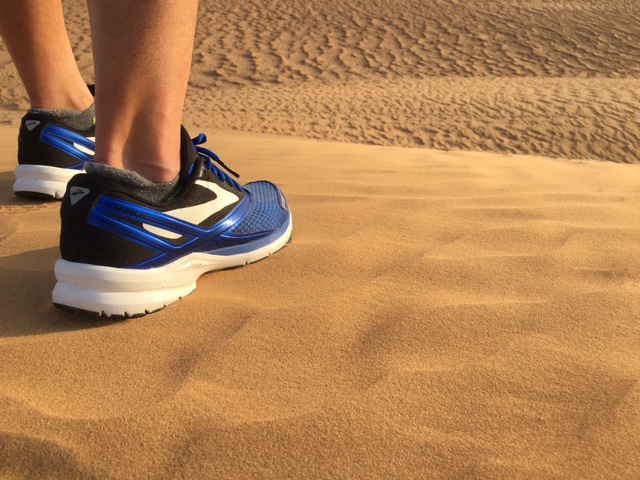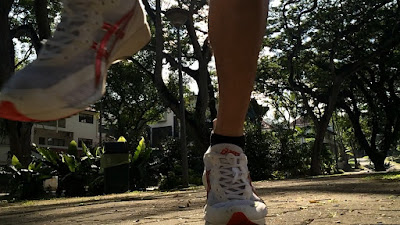REVIEW: Brooks Launch 4
Disclaimer: I purchased this shoe at full retail, and the opinions here are my own.
I’ve previously reviewed the Brooks Launch 3 last year. (see
here
)
This year, the Launch 4 has seen a couple of changes to the
upper and the outsole configuration, but the most striking thing I noticed is
the huge drop in weight (nearly 30g on my scale for a US9.5). I received by
Launch 4 a couple of weeks ago and having been using it on and off in the lead
up to the Dubai Marathon, which I ran on 20 Jan 2017 (2:45:53) and also in the
weeks since.
Without further ado, let’s delve into the details of this
shoe.
Specs:
Weight: 268g / 9.45oz (US 9.5) (claimed weight: 9.2oz for US9.0)
Stack: Heel 28mm, Forefoot 18mm (source: Runningwarehouse)
Insole thickness: ~2mm
MSRP US$100
UPPER
I generally find Brooks uppers to be very durable and reliable.
There are some subtle differences in the uppers of the Launch 3 and Launch 4,
but this is not noticeable on the run. The overlays are somewhat a bit more
plasticky in the Lunch 4, especially where the Brooks logo lies, but this
allowed Brooks to use thinner fabrics in the midfoot and save on a bunch of
weight. They also did away with all overlays towards the forefoot, and allowed
for more elasticity and flexibility in the forefoot upper. The size of the
pores in the forefoot mesh appears unchanged from the Launch 3, but again it
feels slightly thinner. A solid toe bumper is once again present up front,
which serves to elevate the toebox and provide very good vertical room for toe
movement. As one would expect in your typical Brooks trainer, the heel collar
and tongue are afforded excellent padding.
MIDSOLE + OUTSOLE
The midsole continues to sport Brooks’ proprietary BioMoGo
DNA compound which is Brooks’ main non-Newtonian compound of choice.
 One of the key changes seen in the Launch 4 is the
configuration of the outsole rubber. They continue to use softer blown rubber
in a segmented fashion in the front half of the shoe, but while the Launch 3
had 3 rows of blown rubber across the forefoot, the Launch 4 has 4. This
effectively extends the soft blown rubber coverage of the forefoot farther
towards the heel and creates an additional flex point towards the midfoot
section. Overall, this leads to a more natural feeling forefoot transition and
increased flexibility of the shoe at the forefoot. Brooks calls this their
caterpillar crash pad, which allows the shoe to flex with the foot, and a more
robust version of this is seen in the likes of the very popular Brooks Ghost 9.
This was, in my view, a very good move and made a big difference to the ride
for me from the Launch 3.
One of the key changes seen in the Launch 4 is the
configuration of the outsole rubber. They continue to use softer blown rubber
in a segmented fashion in the front half of the shoe, but while the Launch 3
had 3 rows of blown rubber across the forefoot, the Launch 4 has 4. This
effectively extends the soft blown rubber coverage of the forefoot farther
towards the heel and creates an additional flex point towards the midfoot
section. Overall, this leads to a more natural feeling forefoot transition and
increased flexibility of the shoe at the forefoot. Brooks calls this their
caterpillar crash pad, which allows the shoe to flex with the foot, and a more
robust version of this is seen in the likes of the very popular Brooks Ghost 9.
This was, in my view, a very good move and made a big difference to the ride
for me from the Launch 3.
The amount of more durable carbon-injected rubber in the
heel (coined HPR Plus by Brooks) was also pared down with more areas of exposed
midsole, and deeper grooves. All these elements combined to conjure a softer
heel landing with a smoother consistent feel from heel to forefoot.
FIT
The shoe fits true to size for me at US9.5. The shoe uses
the exact same last / platform as the Launch 3. For reference, I wear a 9.5 in
the Launch 3 + Ghost 9, Saucony Kinvara 7 + Triumph ISO2, Nike Pegasus 33, and
Adidas Boston Boost 6.
RIDE
 I found the ride of the Launch 4 to be very smooth, and
noticeably easier to run in than the Launch 3. I am not sure how much of this
is down to the big drop in weight, but it seems more versatile over a wider
range of paces. In terms of ground feel, it is probably closest to the Nike
Pegasus 33, and just a bit firmer than a Skechers GoMeb Razor. Bear in mind
this shoe is meant to be n uptempo shoe and is best run at a faster clip. I did
find that I started to feel sore in the quads at the 1 hour mark on my longer
forays in this shoe, and so it’s probably not working for me as a long run
shoe, unless I am planning to do a faster type of long run. I have not done any
speed work in my Launch 4 beyond the occasional stride workout, but for a daily
trainer, it definitely fits the bill for me.
I found the ride of the Launch 4 to be very smooth, and
noticeably easier to run in than the Launch 3. I am not sure how much of this
is down to the big drop in weight, but it seems more versatile over a wider
range of paces. In terms of ground feel, it is probably closest to the Nike
Pegasus 33, and just a bit firmer than a Skechers GoMeb Razor. Bear in mind
this shoe is meant to be n uptempo shoe and is best run at a faster clip. I did
find that I started to feel sore in the quads at the 1 hour mark on my longer
forays in this shoe, and so it’s probably not working for me as a long run
shoe, unless I am planning to do a faster type of long run. I have not done any
speed work in my Launch 4 beyond the occasional stride workout, but for a daily
trainer, it definitely fits the bill for me.
Comparisons:
Vs Nike Zoom Pegasus 33
These 2 shoes have similar rides and ground feel, with the
Pegasus being slightly more forgiving in the heel, largely due to the thicker
stack, but the Pegasus is also significantly heavier and this becomes
noticeable when I try to do sustained uptempo work. The upper of the Launch
also seems to breath better for me which is important since Singapore running
temps are usually 26-30degC year round. One final issue is shoe rigidity. I
tend to prefer shoes that have a little bit of flexibility in the forefoot, and
the Launch 4 has better flexibility in this respect. I can see myself doing
long runs in the Pegasus 33, but not the Launch 4, so the Pegs gets the nod for
cushioning.
Vs Brooks Ghost 9
I only just started running in the Ghost 9 2 weeks ago, and
so it may not have started breaking in yet, but the Ghost strikes me as a
heavier and more durable version of the Launch 4, without actually being more cushioned from a ground feel and vibration
dampening standpoint. This was somewhat disappointing to me as I was hoping
it would cope as a long run shoe. In essense, if you like the Launch but wear
out shoes very easily, then the Ghost would be a better option for you; very
similar forefoot feel and flexibility, but with more durable overlays and
outsole coverage.
Vs Adidas Boston Boost 6
At its current weight and price-point, the Launch 4 poses a
huge threat to the Adidas Boston Boost 6, which weighs in at 262g for my US9.5
pair. Both shoes are meant to be uptempo shoes. For me, the Boston Boost has
the snugger more secure fit, especially in the heel and midfoot, and there is
definitely more ground throughout the shoe in the Boston, even though v6 is
already softer feeling in the forefoot compared to v5, courtesy of larger,
softer blown rubber pods in the outsole. While the Launch 4 does admirably over
a fairly large range of paces, the Boston really only starts to feel
comfortable and bouncy (i.e. less harsh underfoot) at faster paces. That’s not
a knock on the Boston’s design; it is meant to be run fast, it is simply not as
versatile as the Launch 4. Overall, if you want a shoe that can handle the odd
easy run or maybe even a longer 10-12 miler, then the Launch is less likely to
beat you up. Some people may like a more grounded feel, and for them, the Boston may be good enough to
handle easy runs, but that’s just not the case for me.
VERDICT
Overall score: 4.3/5
I had to bring one trainer along with me to Dubai for my
taper week (I was there a full 7 days before race day), and I chose the Launch
4 for its versatility over a wide range of paces, bearing in mind I had no more
long runs planned. That’s how much I like its versatility.
-0.2 for plasticky upper at the midfoot, which makes the
shoe feel a bit cheap, and made it difficult to get a nice supportive wrap of
the arch.
-0.5 for lack of (for want of a better word) “liveliness” in
the midsole material. These days, many brands have stepped up their game in
terms of midsole technology, with Altra’s EGO midsole, Saucony’s EVERUN, ASICS’s
Flytefoam and Skecher’s 5GEN all giving good energy return and bouncy
characteristics to rival Adidas Boost, and Nike Lunarlon. Brooks seems somewhat
behind with BioMoGo DNA lacking the dynamic properties of some of these newer
foams. That’s pretty much the only knock on Brooks these days. A little too
vanilla perhaps.










The Launch 2 was one of my favourites shoes and the 4 looks like a throwback to the 2 in terms of upper design. Would you happen to know how the Launch 4 heel cushioning compares to the 2?
ReplyDeleteUnfortunately the Launch 2 was the only version I never got around to trying. What I can tell you is that the primary changes are to the forefoot cushioning. Heel cushioning is fairly similar to Launch v1. Hope this helps.
Delete